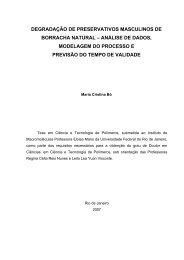EXAFS as a tool for catalyst characterization: a review of the ... - INT
EXAFS as a tool for catalyst characterization: a review of the ... - INT
EXAFS as a tool for catalyst characterization: a review of the ... - INT
You also want an ePaper? Increase the reach of your titles
YUMPU automatically turns print PDFs into web optimized ePapers that Google loves.
Figure 3: Fourier trans<strong>for</strong>m corresponding to <strong>EXAFS</strong> spectrum <strong>of</strong><br />
metallic cobalt.<br />
When <strong>the</strong> contribution <strong>of</strong> two shells is not resolved in <strong>the</strong> Fourier<br />
spectrum, Fourier filtering can be used. By means <strong>of</strong> a filter function,<br />
specific peaks in <strong>the</strong> Fourier spectrum are separated from <strong>the</strong> rest <strong>of</strong><br />
<strong>the</strong> spectrum. The product <strong>of</strong> <strong>the</strong> spectrum with this filter function is<br />
Fourier backtrans<strong>for</strong>med into k space. This procedure separates <strong>the</strong><br />
contribution <strong>of</strong> adjacent coordination shells so that <strong>the</strong> effect <strong>of</strong> only<br />
<strong>the</strong> coordination shell <strong>of</strong> interest is maintained.<br />
In fact, <strong>the</strong> Fourier backtrans<strong>for</strong>m is calculated by<br />
(13)<br />
where W(κ) is <strong>the</strong> window <strong>of</strong> <strong>the</strong> Fourier trans<strong>for</strong>m and W’(κ) is <strong>the</strong><br />
window <strong>of</strong> <strong>the</strong> Fourier backtrans<strong>for</strong>m which separate <strong>the</strong> specific<br />
peak.







![ABM 2012 Torquímetros 20801[1].pdf - INT](https://img.yumpu.com/35773768/1/184x260/abm-2012-torquimetros-208011pdf-int.jpg?quality=85)




![Resumo biodiesel 2012 Raquel Rev cla[1].pdf - INT](https://img.yumpu.com/27723744/1/184x260/resumo-biodiesel-2012-raquel-rev-cla1pdf-int.jpg?quality=85)



